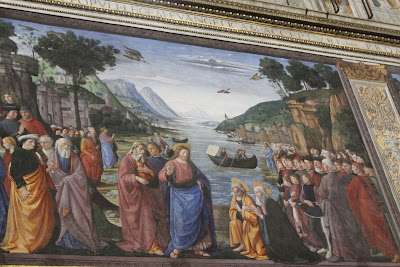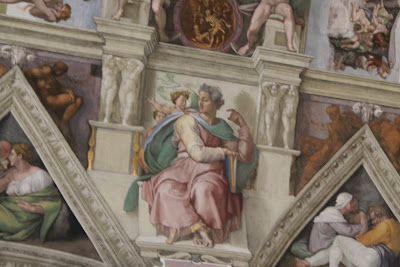 Head of an Amazon, copy of an original bronze made for a competition in Ephesus between 444 and 430 BC. I think this is beyond stunning.
Head of an Amazon, copy of an original bronze made for a competition in Ephesus between 444 and 430 BC. I think this is beyond stunning.The Campidoglio is the modern Italian name for the Capitoline Hill where the major temples and seat of power lay in ancient Rome. Bill had researched all the major museums and knew we would not want to miss the ones here. And wowzer, what incredible art is within. So many works one knows from art history books are right here, the originals in their splendor.
Tonight's posting is just the warmup.
 I was still tired from the Vatican trek the day before. I found this climb daunting. I made it but not without a pause. It was a very sunny day (hence the cap I picked up because I had forgotten my sunblock for the bald spot). The piazza at the top was designed by Michelangelo as are the steps (la Cordonata).
I was still tired from the Vatican trek the day before. I found this climb daunting. I made it but not without a pause. It was a very sunny day (hence the cap I picked up because I had forgotten my sunblock for the bald spot). The piazza at the top was designed by Michelangelo as are the steps (la Cordonata). The original statue is now inside but this copy dominates the piazza. It is of Marcus Aurelius.
The original statue is now inside but this copy dominates the piazza. It is of Marcus Aurelius. A detail of the Palazzo dei Conservatori.
A detail of the Palazzo dei Conservatori. A river god in front of the Palazzo Senatorio, which housed the Senate from the 12th century and is now the office of the mayor of Rome.
A river god in front of the Palazzo Senatorio, which housed the Senate from the 12th century and is now the office of the mayor of Rome. The Palazzo dei Conservatori, seat of the city's magistrates in the late Middle Ages.
The Palazzo dei Conservatori, seat of the city's magistrates in the late Middle Ages. Colossal head of Constantine from the 4th century AD. I really should have someone nearby for scale. It's really big. Hand and foot below.
Colossal head of Constantine from the 4th century AD. I really should have someone nearby for scale. It's really big. Hand and foot below.

The following are other statues and reliefs in the courtyard of the Palazzo dei Conservatori.







 With her parted lips she appears able to breathe or ready to speak. I was quite blown away by the ancient sculptures we saw on this trip.
With her parted lips she appears able to breathe or ready to speak. I was quite blown away by the ancient sculptures we saw on this trip.Partway up the staircase there are several sculpted panels, reliefs in honor of the Emperor Marcus Aurelius. The first is his triumph.

In this panel Marcus Aurelius bestows clemency on two barbarian captives. I have a second shot here in black and white to show detail.


The emperor makes a sacrifice in front of the temple of Capitoline Jupiter.

The emperor enters the city, greeted by the Genius of the Senate, the Genius of the People, and the goddess Roma.

Il Spinario, the famous bronze statue of a boy pulling a thorn from his foot.

Camillus, a youth responsible for ritual duties, with silver inlay eyes, first century AD.

Go, Lobos! [Local University of New Mexico reference there, folks.]
The She-Wolf, from a fifth century BC workshop in Etruria or Magna Graecia, she was an ancient symbol of justice in the Lateran. With the addition of the suckling twin humans, possibly by Pollaiolo, she becomes the Mater Romanorum (Mother of Romans) and symbol of the city.

The head of Medusa by Bernini.


I am thinking this is Marcus Aurelius again.
And that concludes our opening tour. Much more to come.
--the BB






































